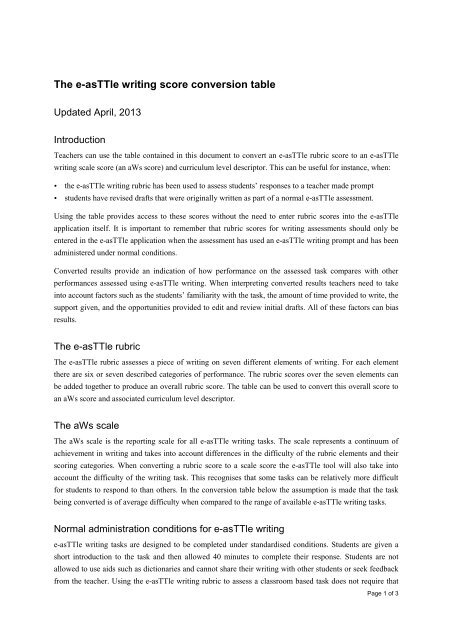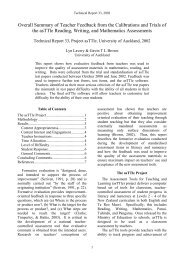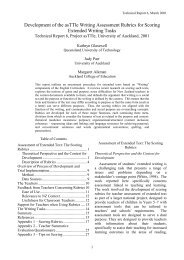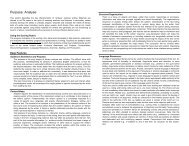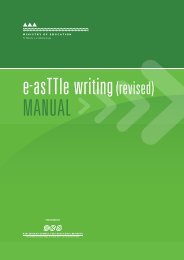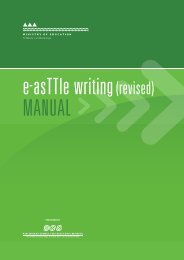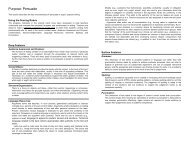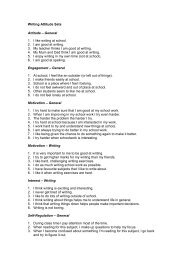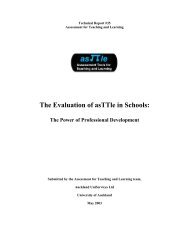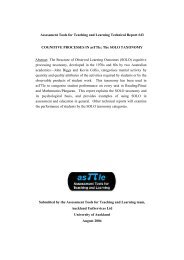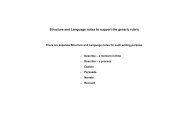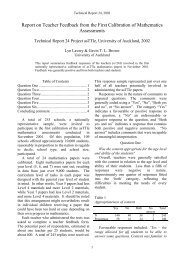Conversion table - rubric scores to scale scores.pdf - e-asTTle
Conversion table - rubric scores to scale scores.pdf - e-asTTle
Conversion table - rubric scores to scale scores.pdf - e-asTTle
You also want an ePaper? Increase the reach of your titles
YUMPU automatically turns print PDFs into web optimized ePapers that Google loves.
The e-<strong>asTTle</strong> writing score conversion <strong>table</strong>Updated April, 2013IntroductionTeachers can use the <strong>table</strong> contained in this document <strong>to</strong> convert an e-<strong>asTTle</strong> <strong>rubric</strong> score <strong>to</strong> an e-<strong>asTTle</strong>writing <strong>scale</strong> score (an aWs score) and curriculum level descrip<strong>to</strong>r. This can be useful for instance, when:the e-<strong>asTTle</strong> writing <strong>rubric</strong> has been used <strong>to</strong> assess students’ responses <strong>to</strong> a teacher made promptstudents have revised drafts that were originally written as part of a normal e-<strong>asTTle</strong> assessment.Using the <strong>table</strong> provides access <strong>to</strong> these <strong>scores</strong> without the need <strong>to</strong> enter <strong>rubric</strong> <strong>scores</strong> in<strong>to</strong> the e-<strong>asTTle</strong>application itself. It is important <strong>to</strong> remember that <strong>rubric</strong> <strong>scores</strong> for writing assessments should only beentered in the e-<strong>asTTle</strong> application when the assessment has used an e-<strong>asTTle</strong> writing prompt and has beenadministered under normal conditions.Converted results provide an indication of how performance on the assessed task compares with otherperformances assessed using e-<strong>asTTle</strong> writing. When interpreting converted results teachers need <strong>to</strong> takein<strong>to</strong> account fac<strong>to</strong>rs such as the students’ familiarity with the task, the amount of time provided <strong>to</strong> write, thesupport given, and the opportunities provided <strong>to</strong> edit and review initial drafts. All of these fac<strong>to</strong>rs can biasresults.The e-<strong>asTTle</strong> <strong>rubric</strong>The e-<strong>asTTle</strong> <strong>rubric</strong> assesses a piece of writing on seven different elements of writing. For each elementthere are six or seven described categories of performance. The <strong>rubric</strong> <strong>scores</strong> over the seven elements canbe added <strong>to</strong>gether <strong>to</strong> produce an overall <strong>rubric</strong> score. The <strong>table</strong> can be used <strong>to</strong> convert this overall score <strong>to</strong>an aWs score and associated curriculum level descrip<strong>to</strong>r.The aWs <strong>scale</strong>The aWs <strong>scale</strong> is the reporting <strong>scale</strong> for all e-<strong>asTTle</strong> writing tasks. The <strong>scale</strong> represents a continuum ofachievement in writing and takes in<strong>to</strong> account differences in the difficulty of the <strong>rubric</strong> elements and theirscoring categories. When converting a <strong>rubric</strong> score <strong>to</strong> a <strong>scale</strong> score the e-<strong>asTTle</strong> <strong>to</strong>ol will also take in<strong>to</strong>account the difficulty of the writing task. This recognises that some tasks can be relatively more difficultfor students <strong>to</strong> respond <strong>to</strong> than others. In the conversion <strong>table</strong> below the assumption is made that the taskbeing converted is of average difficulty when compared <strong>to</strong> the range of available e-<strong>asTTle</strong> writing tasks.Normal administration conditions for e-<strong>asTTle</strong> writinge-<strong>asTTle</strong> writing tasks are designed <strong>to</strong> be completed under standardised conditions. Students are given ashort introduction <strong>to</strong> the task and then allowed 40 minutes <strong>to</strong> complete their response. Students are notallowed <strong>to</strong> use aids such as dictionaries and cannot share their writing with other students or seek feedbackfrom the teacher. Using the e-<strong>asTTle</strong> writing <strong>rubric</strong> <strong>to</strong> assess a classroom based task does not require thatPage 1 of 3
the task has been done in standardised conditions. It is important <strong>to</strong> realise however, that the conditionsunder which the task is done will affect performance and, as has been stated, differences in conditionsshould be taken in<strong>to</strong> account when interpreting a result or making comparisons between achievement ondifferent tasks.ErrorThe <strong>table</strong> provides an error range for each <strong>scale</strong> score. This is a range of values around the <strong>scale</strong> scorewithin which we can be reasonably confident the student’s “true score” lies. For instance, an error of 58units indicates that about 70% of the time, the given <strong>scale</strong> score will be within plus or minus 58 units of thestudent’s true location on the <strong>scale</strong>. The error reported is conservative. It does not take in<strong>to</strong> account biasesthat might occur because students complete a task in more favourable conditions than are normally allowedfor e-<strong>asTTle</strong> writing.Curriculum level descrip<strong>to</strong>rsThe <strong>table</strong> also shows the link between <strong>scale</strong> <strong>scores</strong> and curriculum levels descrip<strong>to</strong>rs. A descrip<strong>to</strong>r of 2Afor instance, indicates that the <strong>scale</strong> score is appropriate for someone working at an advanced level forcurriculum level 2. Again it is important <strong>to</strong> note that each curriculum level descrip<strong>to</strong>r is linked <strong>to</strong> theperformance level expected from a student doing a normal e-<strong>asTTle</strong> writing assessment. If students havehad additional time or support, the curriculum level descrip<strong>to</strong>r may over estimate their achievement level.Page 2 of 3
Table 1 The e-<strong>asTTle</strong> writing score conversion <strong>table</strong>TotalscoreScalescore(aWs)Measurementerror (aWs)CurriculumlevelTotalscoreScalescore(aWs)Measurementerror (aWs)Curriculumlevel7 745 >134 1B 27 1540 45 3P8 907 121 1B 28 1558 44 3A9 1036 72 1B 29 1576 44 3A10 1092 60 1B 30 1594 44 4B11 1133 56 1B 31 1612 44 4B12 1169 54 1B13 1202 53 1B14 1234 53 1P15 1264 52 1P16 1293 51 1P17 1320 50 1A18 1346 49 1A19 1371 49 2B20 1395 48 2B21 1418 47 2P22 1441 47 2P23 1462 46 2A24 1483 46 2A32 1629 44 4P33 1647 44 4P34 1665 44 4A35 1682 44 4A36 1700 45 5B37 1719 45 5B38 1739 46 5B39 1760 47 5P40 1784 49 6B41 1812 52 6B42 1848 59 >6B43 1903 73 >6B44 1986 >119 >6B25 1502 45 3B26 1521 45 3BFor more information about using the e-<strong>asTTle</strong> <strong>rubric</strong>, particularly with classroom based tasks, and the aWs<strong>scale</strong>, teachers should refer <strong>to</strong> the e-<strong>asTTle</strong> writing teacher manual. This is available on the TKI website.Page 3 of 3


